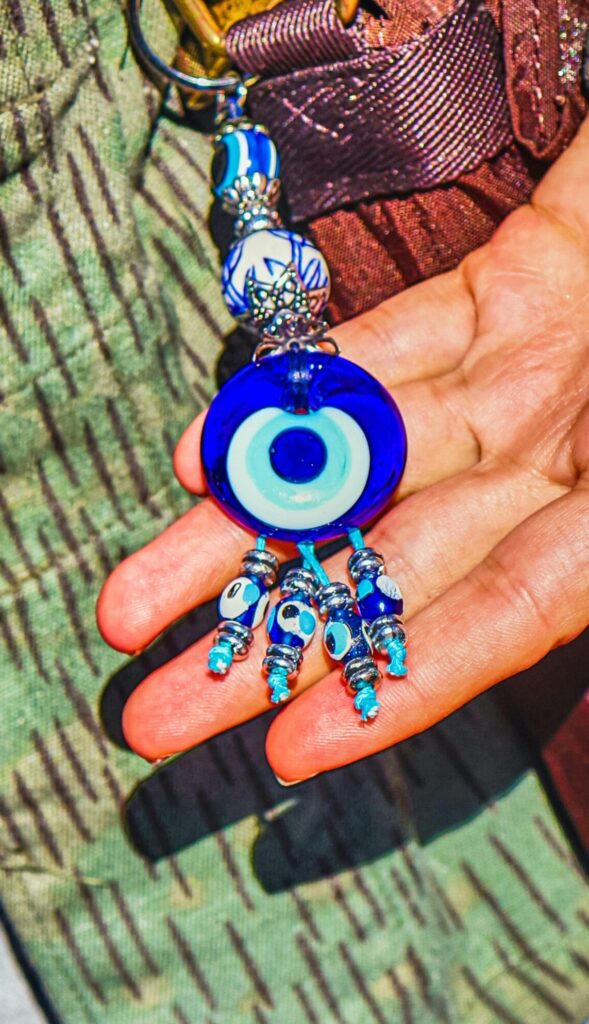Overview
The evil eye, or Nazar, is an ancient protective symbol believed to guard against malevolent stares that can bring harm, bad luck, or misfortune. Found in cultures from the Mediterranean to South Asia, its iconic blue-and-white design reflects back envious energy and acts as a spiritual shield. Today, the evil eye is worn as jewelry, displayed in homes, and woven into ritual practices as both a folkloric charm and a contemporary expression of ancestral protection.

History & Practices
The concept of the evil eye dates back thousands of years, transcending cultural, religious, and geographic boundaries. At its core, the evil eye is the belief that envy or ill will, projected through a gaze, can cause physical or metaphysical harm. The “Nazar” (most commonly depicted as a concentric blue-and-white eye) is the symbolic antidote: a charm worn or displayed to deflect these malevolent glances. While the name Nazar stems from Arabic (نظر, meaning “sight” or “glance”), the motif itself is far older, with evidence of similar amulets found in Mesopotamia, Ancient Greece, and even in the ruins of ancient Anatolia.
Historians trace the earliest written reference to the evil eye to around 3,000 BCE in Sumerian cuneiform tablets, with parallel references appearing in Babylonian texts and Hittite mythology. In Ancient Greece, the philosopher Plutarch wrote about the destructive force of envy transmitted through the eyes, suggesting that some individuals possess an inner poison that can harm others. This belief persisted through the Roman Empire and beyond, where protective inscriptions were carved into walls and vessels. The Romans even used phallic imagery alongside eyes in mosaics, a strange but intentional coupling of fertility and warding symbols. In Jewish mysticism, the ayin hara (Hebrew for “evil eye”) plays a central role in the Kabbalistic understanding of energy, while in Islam, the Prophet Muhammad acknowledged its reality, advising followers to recite protective prayers such as Al-Falaq and An-Naas.
Archaeologists have discovered evil eye beads buried in graves, strung around infants’ wrists, and embedded in ancient architecture. The motif exploded in visibility during the Ottoman Empire, especially in Turkish folk culture, where the glass-blown nazar boncuğu became an iconic staple. These beads were traditionally made in village kilns near Izmir, Turkey, where the intense blues were believed to carry the cleansing force of water and the warding power of heaven. Across the Mediterranean, you’ll find variations of the same symbol: the Greek mati, the Italian malocchio, the Persian cheshm nazar, and the Hindu drishti dosha, each adapted to local cosmologies but united in purpose.
In modern culture, the evil eye has experienced a dramatic resurgence on the catwalk, on social media, and in contemporary spirituality. It has transcended mere superstition to become a symbol of ancestral wisdom, resilience, and energetic hygiene. Fashion designers like Kenzo, Dior, and Alexander McQueen have all featured the eye motif, while celebrities such as Gigi Hadid and Meghan Markle have worn Nazar charms, sparking renewed global interest. In spiritual spaces, the evil eye is often included in protection rituals, combined with smoke cleansing, salt lines, or affirmations to shield the wearer from toxic energies.
Today, the evil eye continues to reflect the enduring human need for metaphysical boundaries, communal protection, and spiritual self-defense. Whether you see it hanging from a rearview mirror, stitched into a baby blanket, or tattooed on skin, the Nazar remains a vibrant, cross-cultural talisman charged with the power to ward off envy, amplify intention, and remind us that some gazes carry weight. The eye looks back … and in doing so, it protects.
